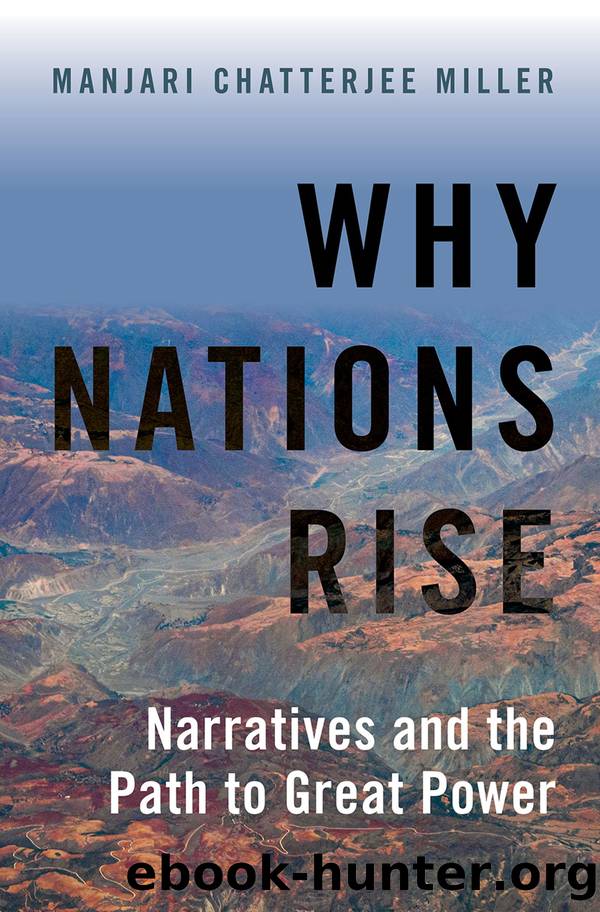Why Nations Rise by Manjari Chatterjee Miller;

Author:Manjari Chatterjee Miller;
Language: eng
Format: epub, pdf
Publisher: OUP Premium
Published: 2020-06-15T00:00:00+00:00
5
The Active Rise of China
In 1992, Barber Conable and David M. Lampton published an article in Foreign Affairs that carried a stark warning. They argued that the United States was dangerously underestimating Chinaâthat Americans comfortably but erroneously assumed the collapse of the Soviet Union meant that China no longer held any strategic value.1 The following year, New York Times journalist Nicholas Kristof, in an article titled âThe Rise of China,â wrote that the only group in America paying âserious attentionâ to China was the business community.2 In todayâs world, with the 2017 National Security Strategy document of the Trump administration labeling China the United Statesâ number one adversary, these warnings seem prescient. Even Chinese historians have talked of Chinaâs rise as inevitable, a part of a longer arc of power transition. The historian Wang Gungwu famously observed that this is Chinaâs fourth rise; the sheer size of China and the consequent âpolitical weightâ bestowed upon it, he argued, âcannot be wished away.â3 But in the very early 1990s, at the time these warnings were published, any discussion of Chinaâs rise was not only unusual, but also superfluous. For the United States, fixated as it had been on Japan as the next challenger, China was neither an adversary nor even a rival.
Instead, China was a developing country with an authoritarian regime, and beyond that, after the Tiananmen Square massacre in June 1989, also a pariah state. Yet a mere two decades later, in 2008, the New York Times would be pointing out, âNo one worries much about Japan taking over the world today. When we wring our hands, itâs China we fear.â4 Thus, somewhere in those years of the 1990s and 2000s, China shifted, in the American mainstream perception, from poor pariah to a ârising economic superpower.â5 By 2002, the journal Foreign Affairs had collected all of its pertinent articles on China and republished them as a volume titled Rising China. The debate was not whether China was rising; rather, it was whether China would be a challenger power or maintain the status quo. And the world, in turn, debated how it should respond: should China be treated as a threat or as an opportunity?6 Buried in such angst-ridden questions about the rise of a possible threatening power lie bigger questions: What categorized China as a rising power? And was its behavior indeed revisionist?
If we look at China in the 1990s we find a shift in both military and economic power. Chinaâs economic reforms, initiated by Deng Xiaopingâs politics of opening and reform (gaige kaifang) in the 1980s, had resulted in a booming economy. China had also begun to expand its military capabilities, and it already owned that ultimate postâWorld War II military capabilityânuclear weapons. But material power was not the only difference between pre- and post-1990s China. Chinaâs behavior on the world stage also began to change. While this behavior was scrutinized as a possible threat to the postâCold War world, as we will see, much of it was in line with the behavior we have, in this book, come to expect of active rising powers.
Download
Why Nations Rise by Manjari Chatterjee Miller;.pdf
This site does not store any files on its server. We only index and link to content provided by other sites. Please contact the content providers to delete copyright contents if any and email us, we'll remove relevant links or contents immediately.
Chaco's Northern Prodigies : Salmon, Aztec, and the Ascendancy of the Middle San Juan Region after AD 1100 by Paul F. Reed(355)
Law Enforcement Interpersonal Communication and Conflict Management by Brian Douglas Fitch(347)
Digital International Relations by Unknown(344)
Critical Perspectives on Human Security : Rethinking Emancipation and Power in International Relations by David Chandler; Nik Hynek(329)
Skilled interpersonal communication: Research, theory and practice, Fifth edition by Owen Hargie(326)
The Enduring Color Line in U.S. Athletics by Krystal Beamon Chris M. Messer(323)
Evidence-Based Policy Making in Labor Economics by Hamermesh Daniel S.;Nottmeyer Olga K.;Nottmeyer Olga;King Sarah;King Sarah;King Sarah;(297)
EPSO CAST Political affairs EU policies: How to succeed in the selection procedure by Franco Reverte José María(290)
Writing Public Policy - A Practical Guide to Communicating in the Policy Making Process by Catherine F. Smith(272)
Criminological Theory in Context by John Martyn Chamberlain(269)
Tibeton Yoga Its Secret Doc by Evans-Wentz(266)
Threshold Concepts in Women's and Gender Studies by Christie Launius Holly Hassel(263)
Rothschild and Early Jewish Colonization in Palestine (Geographical Perspectives on the Human Past) by Ran Aaronsohn(263)
Positive Psychology and Spirituality in Counselling and Psychotherapy (Conflict, Ethics, and Spirituality, 12) by unknow(261)
Social Problems, Social Issues, Social Science by James Wright(259)
Play in child development and psychotherapy: toward empirically supported practice by Sandra W. Russ(252)
Cognitive Development in Infancy and Childhood (Elements in Child Development) by Mary Gauvain(252)
Latin American Politics and Society by Gerardo L. Munck & Juan Pablo Luna(222)
What Makes a Social Crisis?: The Societalization of Social Problems by Jeffrey C. Alexander(220)
